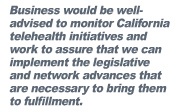By: Brenda J. Trainor
 How can a concept like telemedicine help our economy? Critical for our collective economic health, and for business operations in particular, is the need to keep health care costs down. The application of information technologies in health care provides many good opportunities for innovation and progress to stem the tide of rising health care costs. How can a concept like telemedicine help our economy? Critical for our collective economic health, and for business operations in particular, is the need to keep health care costs down. The application of information technologies in health care provides many good opportunities for innovation and progress to stem the tide of rising health care costs.
But as with any new application of technology, there can be complications, and sometimes a steep learning curve. But there are exciting developments, great demonstration projects, and some outstanding examples of good progress in overcoming some of the obstacles.
As Californians, we are lucky to have some dedicated professionals working on developing telemedicine networks and applications – the California Telehealth Network (www.caltelehealth.org) is the product of a coalition of professional, academic and medical organizations, initially funded with hundreds of millions of federal and state dollars, devoted to “promote advanced information technologies and services to improve access to high quality health care.” Since 2006 this organization has been working on developing, monitoring, and documenting projects that demonstrate the effectiveness of telemedicine applications.
Let’s examine some of the innovations and solutions that fall under the general category of “telemedicine:”
At its very simplest, telemedicine might be just a phone call to your doctor, or a discussion with a nurse about your child’s fever and getting a recommendation for treatment. And at the other end of the scale, are exciting developments in robotic surgery performed by a specialist thousands of miles away from the patient.
In between these extremes are innovations in diagnostics, delivering health care to remote locations, and providing health care to underserved populations. There are telehealth applications in all fields of medicine: from optometry to dentistry to psychology to surgery for all levels of service whether pediatrics or gerontology.

One of the key advantages that telemedicine offers is the ability to overcome distance by making healthcare more accessible to patients. Specialists who tend to practice in urban academic research facilities are often not available to patients in rural areas. The complications of transporting patients to the caregiver and a specialized facility can be logistically and financially prohibitive. But telemedicine applications can provide options for such patients and eliminate travel costs and provide services that would otherwise be unavailable.
With telemedicine, health care practitioners can use different innovations to create efficiencies in time management and improved service delivery. For example, video conferencing can be used to interview patients, consult with specialists, or confer with radiologists. With advanced telecommunications services, practitioners can share massive amounts of data quickly, improving real-time analyses, and making more accurate diagnosis of conditions.
To make these kinds of telemedicine applications truly functional, there must be good transmitting and receiving equipment and a network that is sufficiently robust to handle the data streams that are required. (And to underscore the importance of the network integrity necessary for telemedicine, it should not be surprising that the executive director of the CA Telehealth Network is an accomplished executive from the cable television industry.) For some applications, like surgical robotics, the data stream must carry real-time measurements of vital signs, detailed radiological images, streams of high definition microlens videos with digital audio feeds, all coupled with telemetry signals that control surgical instruments – and such a network can have no delays or blips or signal interference. Not all applications are so complex from a technology perspective, but the channel of communication is a key consideration for effective telemedicine.
A less technological complication, typical of launching any new technology, is assuring that rules, regulations and laws adjust to the possibilities that technology affords. Medicine is a highly-regulated field, and practitioners must be properly credentialed and licensed. Generally, these kinds of regulations are managed on a state-by-state basis; county health agencies authorize payments and manage case loads for a variety of services. But with telemedicine applications that are designed to eliminate the complications of distance, the possibility of multi-jurisdictional services must be negotiated. When communications between patient and caregiver are located in different jurisdictions the rules that govern the delivery of service must become compliant. And that’s where some major legislative initiatives can crank up the bureaucratic machine, adding the complications of time and politics to the telemedicine prescription.
Telemedicine may well offer some promising solutions to the health care funding crisis that businesses currently face – business would be well-advised to monitor California telehealth initiatives and work to assure that we can implement the legislative and network advances that are necessary to bring them to fulfillment.


|